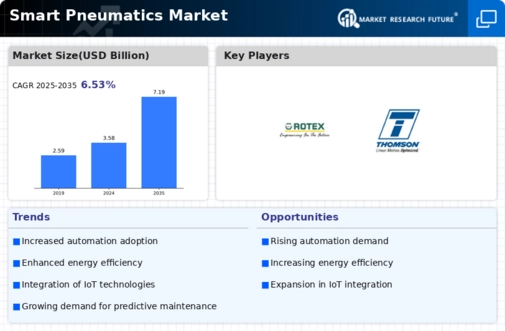-
Executive Summary
-
Scope of the Report
-
Market Definition
-
Scope of the Study
-
Research Objectives
-
Markets Structure
-
Research Methodology
-
Market Landscape
-
Porter’s Five Forces Analysis
- Threat of New Entrants
- Bargaining Power of Buyers
- Threat of Substitutes
- Segment Rivalry
- Bargaining Power of Suppliers
-
Value Chain/Supply Chain of Smart Pneumatics
-
Market Landscape
-
Introduction
-
Growth Drivers
-
Impact Analysis
-
Market Challenges
-
Market Trends
-
Introduction
-
Growth Trends
-
Impact Analysis
-
-
Smart Pneumatics Market by Type
-
Introduction
-
Smart Pneumatic Valves
- Market Estimates & Forecast, 2024–2032
-
Smart Pneumatic Actuators
- Market Estimates & Forecast, 2024–2032
-
Smart Pneumatic Modules
- Market Estimates & Forecast, 2024–2032
-
Smart Pneumatics Market by Component
-
Introduction
-
Hardware
- Market Estimates & Forecast, 2024–2032
- Sensors
- Communication Equipment
-
Software
- Market Estimates & Forecast, 2024–2032
- Data Integration Software
- Diagnostic Reporting
- Parameter Calculation
-
Smart Pneumatics Market by End User
-
Introduction
-
Automotive
- Market Estimates & Forecast, 2024–2032
-
Oil & Gas
- Market Estimates & Forecast, 2024–2032
-
Food & Beverage
- Market Estimates & Forecast, 2024–2032
-
Energy & Power
- Market Estimates & Forecast, 2024–2032
-
Others
- Market Estimates & Forecast, 2024–2032
-
Smart Pneumatics Market by Region
-
Introduction
-
North America
- Market Estimates & Forecast, by Country, 2024–2032
- Market Estimates & Forecast, by Type, 2024–2032
- Market Estimates & Forecast, by Component, 2024–2032
- Market Estimates & Forecast, by End User, 2024–2032
- US
- Mexico
- Canada
-
Europe
- Market Estimates & Forecast, by Country, 2024–2032
- Market Estimates & Forecast, by Type, 2024–2032
- Market Estimates & Forecast, by Component, 2024–2032
- Market Estimates & Forecast, by End User, 2024–2032
- Germany
- France
- Italy
- Spain
- UK
-
Asia-Pacific
- Market Estimates & Forecast, by Country, 2024–2032
- Market Estimates & Forecast, by Type, 2024–2032
- Market Estimates & Forecast, by Component, 2024–2032
- Market Estimates & Forecast, by End User, 2024–2032
- China
- India
- Japan
- Rest of Asia-Pacific
-
Rest of the World
- Market Estimates & Forecast, by Country, 2024–2032
- Market Estimates & Forecast, by Type, 2024–2032
- Market Estimates & Forecast, by Component, 2024–2032
- Market Estimates & Forecast, by End User, 2024–2032
- Middle East & Africa
- Latin America
-
Competitive Landscape
-
Company Profiles
-
Emerson Electric
- Company Overview
- Type/Business Segment Overview
- Financial Updates
- Key Developments
- SWOT Analysis
- Key Strategies
-
Festo
- Company Overview
- Type/Business Segment Overview
- Financial Updates
- Key Developments
- SWOT Analysis
- Key Strategies
-
Parker Hannifin
- Company Overview
- Type/Business Segment Overview
- Financial Updates
- Key Developments
- SWOT Analysis
- Key Strategies
-
Bimba Manufcatruing
- Company Overview
- Type/Business Segment Overview
- Financial Updates
- Key Developments
- SWOT Analysis
- Key Strategies
-
Rotork
- Company Overview
- Type/Business Segment Overview
- Financial Updates
- Key Developments
- SWOT Analysis
- Key Strategies
-
Rotex Automation Limited
- Company Overview
- Type/Business Segment Overview
- Financial Updates
- Key Developments
- SWOT Analysis
- Key Strategies
-
Thomson Industries
- Company Overview
- Type/Business Segment Overview
- Financial Updates
- Key Developments
- SWOT Analysis
- Key Strategies
-
AVENTICS GmbH
- Company Overview
- Type/Business Segment Overview
- Financial Updates
- Key Developments
- SWOT Analysis
- Key Strategies
-
Cypress Envirosystems
- Company Overview
- Type/Business Segment Overview
- Financial Updates
- Key Developments
- SWOT Analysis
- Key Strategies
-
Ningbo Smart Pneumatic Co. Ltd
- Company Overview
- Type/Business Segment Overview
- Financial Updates
- Key Developments
- SWOT Analysis
- Key Strategies
-
Conclusion
-
LIST OF TABLES
-
Global Smart Pneumatics Market, by Type, 2024–2032
-
Global Smart Pneumatics Market, by Component, 2024–2032
-
Global Smart Pneumatics Market, by End User, 2024–2032
-
Global Smart Pneumatics Market, by Region, 2024–2032
-
North America: Smart Pneumatics Market, by Country, 2024–2032
-
North America Smart Pneumatics, Market, by Type, 2024–2032
-
North America Smart Pneumatics, Market, by Component, 2024–2032
-
North America Smart Pneumatics, Market, by End User, 2024–2032
-
US Smart Pneumatics, Market, by Type, 2024–2032
-
US Smart Pneumatics, Market, by Component, 2024–2032
-
US Smart Pneumatics Market, by End User, 2024–2032
-
Canada Smart Pneumatics, Market, by Type, 2024–2032
-
Canada Smart Pneumatics, Market, by Component, 2024–2032
-
Canada Smart Pneumatics, Market, by End User, 2024–2032
-
Mexico Smart Pneumatics, Market, by Type, 2024–2032
-
Mexico Smart Pneumatics, Market, by Component, 2024–2032
-
Mexico Smart Pneumatics, Market, by End User, 2024–2032
-
Europe Smart Pneumatics Market, by Country, 2024–2032
-
Europe Smart Pneumatics Market, by Type, 2024–2032
-
Europe Smart Pneumatics Market, by Component, 2024–2032
-
Europe Smart Pneumatics Market, by End User, 2024–2032
-
Germany Smart Pneumatics Market, by Type, 2024–2032
-
Germany Smart Pneumatics Market, by Component, 2024–2032
-
Germany Smart Pneumatics Market, by End User, 2024–2032
-
France Smart Pneumatics Market, by Type, 2024–2032
-
France Smart Pneumatics Market, by Type, 2024–2032
-
France Smart Pneumatics Market, by End User, 2024–2032
-
UK Smart Pneumatics Market, by Type, 2024–2032
-
UK Smart Pneumatics Market, by Component, 2024–2032
-
UK Smart Pneumatics Market, by End User, 2024–2032
-
Spain Smart Pneumatics Market, by Type, 2024–2032
-
Spain Smart Pneumatics Market, by Component, 2024–2032
-
Spain Smart Pneumatics Market, by End User, 2024–2032
-
Italy Smart Pneumatics Market, by Type, 2024–2032
-
Italy Smart Pneumatics Market, by Component, 2024–2032
-
Italy Smart Pneumatics Market, by End User, 2024–2032
-
Asia-Pacific Smart Pneumatics Market, by Country, 2024–2032
-
Asia-Pacific Smart Pneumatics Market, by Type, 2024–2032
-
Asia-Pacific Smart Pneumatics Market, by Component, 2024–2032
-
Asia-Pacific Smart Pneumatics Market, by End User, 2024–2032
-
China Smart Pneumatics Market, by Type, 2024–2032
-
China Smart Pneumatics Market, by Type, 2024–2032
-
China Smart Pneumatics Market, by End User, 2024–2032
-
Japan Smart Pneumatics Market, by Type, 2024–2032
-
Japan Smart Pneumatics Market, by Type
-
Japan Smart Pneumatics Market, by End User, 2024–2032
-
India Smart Pneumatics Market, by Type, 2024–2032
-
India Smart Pneumatics Market, by Component, 2024–2032
-
India Smart Pneumatics Market, by End User, 2024–2032
-
Rest of Asia-Pacific Smart Pneumatics Market, by Type, 2024–2032
-
Rest of Asia-Pacific Smart Pneumatics Market, by Component 2024–2032
-
Rest of Asia-Pacific Smart Pneumatics Market, by End User, 2024–2032
-
Rest of the World Smart Pneumatics Market, by Country, 2024–2032
-
Rest of the World Smart Pneumatics Market, by Type, 2024–2032
-
Rest of the World Smart Pneumatics Market, by Component, 2024–2032
-
Rest of the World Smart Pneumatics Market, by End User, 2024–2032
-
-
LIST OF FIGURES
-
Global Smart Pneumatics Market Segmentation
-
Forecast Methodology
-
Porter’s Five Forces Analysis of Global Smart Pneumatics Market
-
Value Chain of Global Smart Pneumatics Market
-
Share of Global Smart Pneumatics Market in 2020, by Country (in %)
-
Global Smart Pneumatics Market, 2024–2032
-
Sub-segments of Type
-
Global Smart Pneumatics Market Size, by Type, 2020
-
Share of Global Smart Pneumatics Market, by Type, 2024 to 2032
-
Sub-segments of Component
-
Global Smart Pneumatics Market Size, by Component, 2020
-
Share of Global Smart Pneumatics Market, by Component, 2024 to 2032
-
Sub-segments of End-User
-
Global Smart Pneumatics Market Size, by End-User, 2020
-
Share of Global Smart Pneumatics Market, by End-User, 2024 to 2032








Leave a Comment